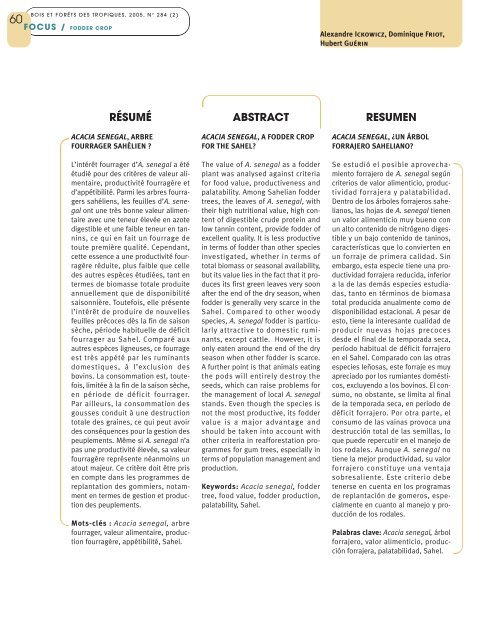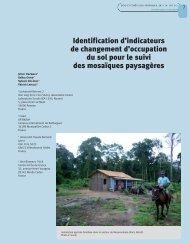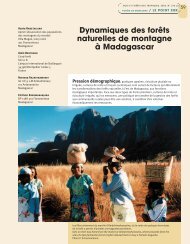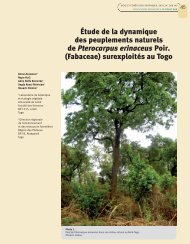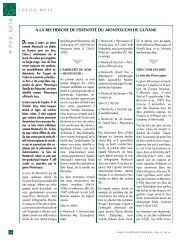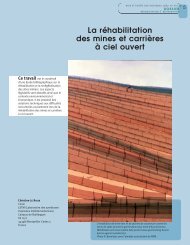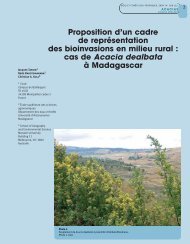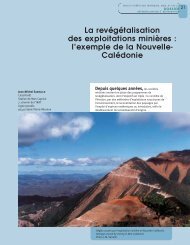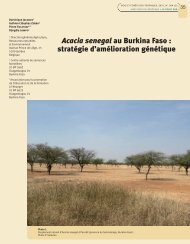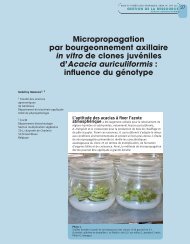Acacia senegal, arbre fourrager sahélien ? - Bois et forêts des ...
Acacia senegal, arbre fourrager sahélien ? - Bois et forêts des ...
Acacia senegal, arbre fourrager sahélien ? - Bois et forêts des ...
You also want an ePaper? Increase the reach of your titles
YUMPU automatically turns print PDFs into web optimized ePapers that Google loves.
60<br />
BOIS ET FORÊTS DES TROPIQUES, 2005, N° 284 (2)<br />
FOCUS / FODDER CROP<br />
RÉSUMÉ<br />
ACACIA SENEGAL, ARBRE<br />
FOURRAGER SAHÉLIEN ?<br />
L’intérêt <strong>fourrager</strong> d’A. <strong>senegal</strong> a été<br />
étudié pour <strong>des</strong> critères de valeur alimentaire,<br />
productivité fourragère <strong>et</strong><br />
d’appétibilité. Parmi les <strong>arbre</strong>s <strong>fourrager</strong>s<br />
<strong>sahélien</strong>s, les feuilles d’A. <strong>senegal</strong><br />
ont une très bonne valeur alimentaire<br />
avec une teneur élevée en azote<br />
digestible <strong>et</strong> une faible teneur en tannins,<br />
ce qui en fait un fourrage de<br />
toute première qualité. Cependant,<br />
c<strong>et</strong>te essence a une productivité fourragère<br />
réduite, plus faible que celle<br />
<strong>des</strong> autres espèces étudiées, tant en<br />
termes de biomasse totale produite<br />
annuellement que de disponibilité<br />
saisonnière. Toutefois, elle présente<br />
l’intérêt de produire de nouvelles<br />
feuilles précoces dès la fin de saison<br />
sèche, période habituelle de déficit<br />
<strong>fourrager</strong> au Sahel. Comparé aux<br />
autres espèces ligneuses, ce fourrage<br />
est très appété par les ruminants<br />
domestiques, à l’exclusion <strong>des</strong><br />
bovins. La consommation est, toutefois,<br />
limitée à la fin de la saison sèche,<br />
en période de déficit <strong>fourrager</strong>.<br />
Par ailleurs, la consommation <strong>des</strong><br />
gousses conduit à une <strong>des</strong>truction<br />
totale <strong>des</strong> graines, ce qui peut avoir<br />
<strong>des</strong> conséquences pour la gestion <strong>des</strong><br />
peuplements. Même si A. <strong>senegal</strong> n’a<br />
pas une productivité élevée, sa valeur<br />
fourragère représente néanmoins un<br />
atout majeur. Ce critère doit être pris<br />
en compte dans les programmes de<br />
replantation <strong>des</strong> gommiers, notamment<br />
en termes de gestion <strong>et</strong> production<br />
<strong>des</strong> peuplements.<br />
Mots-clés : <strong>Acacia</strong> <strong>senegal</strong>, <strong>arbre</strong><br />
<strong>fourrager</strong>, valeur alimentaire, production<br />
fourragère, appétibilité, Sahel.<br />
ABSTRACT<br />
ACACIA SENEGAL, A FODDER CROP<br />
FOR THE SAHEL?<br />
The value of A. <strong>senegal</strong> as a fodder<br />
plant was analysed against criteria<br />
for food value, productiveness and<br />
palatability. Among Sahelian fodder<br />
trees, the leaves of A. <strong>senegal</strong>, with<br />
their high nutritional value, high content<br />
of digestible crude protein and<br />
low tannin content, provide fodder of<br />
excellent quality. It is less productive<br />
in terms of fodder than other species<br />
investigated, wh<strong>et</strong>her in terms of<br />
total biomass or seasonal availability,<br />
but its value lies in the fact that it produces<br />
its first green leaves very soon<br />
after the end of the dry season, when<br />
fodder is generally very scarce in the<br />
Sahel. Compared to other woody<br />
species, A. <strong>senegal</strong> fodder is particularly<br />
attractive to domestic ruminants,<br />
except cattle. However, it is<br />
only eaten around the end of the dry<br />
season when other fodder is scarce.<br />
A further point is that animals eating<br />
the pods will entirely <strong>des</strong>troy the<br />
seeds, which can raise problems for<br />
the management of local A. <strong>senegal</strong><br />
stands. Even though the species is<br />
not the most productive, its fodder<br />
value is a major advantage and<br />
should be taken into account with<br />
other criteria in reafforestation programmes<br />
for gum trees, especially in<br />
terms of population management and<br />
production.<br />
Keywords: <strong>Acacia</strong> <strong>senegal</strong>, fodder<br />
tree, food value, fodder production,<br />
palatability, Sahel.<br />
Alexandre Ickowicz, Dominique Friot,<br />
Hubert Guérin<br />
RESUMEN<br />
ACACIA SENEGAL, ¿UN ÁRBOL<br />
FORRAJERO SAHELIANO?<br />
Se estudió el posible aprovechamiento<br />
forrajero de A. <strong>senegal</strong> según<br />
criterios de valor alimenticio, productividad<br />
forrajera y palatabilidad.<br />
Dentro de los árboles forrajeros sahelianos,<br />
las hojas de A. <strong>senegal</strong> tienen<br />
un valor alimenticio muy bueno con<br />
un alto contenido de nitrógeno digestible<br />
y un bajo contenido de taninos,<br />
características que lo convierten en<br />
un forraje de primera calidad. Sin<br />
embargo, esta especie tiene una productividad<br />
forrajera reducida, inferior<br />
a la de las demás especies estudiadas,<br />
tanto en términos de biomasa<br />
total producida anualmente como de<br />
disponibilidad estacional. A pesar de<br />
esto, tiene la interesante cualidad de<br />
producir nuevas hojas precoces<br />
<strong>des</strong>de el final de la temporada seca,<br />
período habitual de déficit forrajero<br />
en el Sahel. Comparado con las otras<br />
especies leñosas, este forraje es muy<br />
apreciado por los rumiantes domésticos,<br />
excluyendo a los bovinos. El consumo,<br />
no obstante, se limita al final<br />
de la temporada seca, en período de<br />
déficit forrajero. Por otra parte, el<br />
consumo de las vainas provoca una<br />
<strong>des</strong>trucción total de las semillas, lo<br />
que puede repercutir en el manejo de<br />
los rodales. Aunque A. <strong>senegal</strong> no<br />
tiene la mejor productividad, su valor<br />
forrajero constituye una ventaja<br />
sobresaliente. Este criterio debe<br />
tenerse en cuenta en los programas<br />
de replantación de gomeros, especialmente<br />
en cuanto al manejo y producción<br />
de los rodales.<br />
Palabras clave: <strong>Acacia</strong> <strong>senegal</strong>, árbol<br />
forrajero, valor alimenticio, producción<br />
forrajera, palatabilidad, Sahel.


